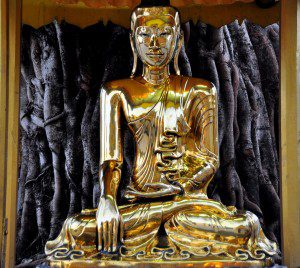 It’s not that often that I post about practice these days. But last night, unable to sleep for a variety of reasons (green tea, cola, and a very dramatic film included), I spent some time browsing Access to Insight (because that’s what people do when they have free time, right?).
It’s not that often that I post about practice these days. But last night, unable to sleep for a variety of reasons (green tea, cola, and a very dramatic film included), I spent some time browsing Access to Insight (because that’s what people do when they have free time, right?).
So I checked the simile section, which is fantastic – you all should go there now.
The first simile (in alphabetical order) is acrobats. Not too interesting. Then the “ancient city.” Been there. Done that.
The third one is: Animals bound together by a rope:{lack of mindfulness} SN 35.206
That sounds interesting.
While my sleep-deprived mind was looking for ideas in Buddhist Ethics, I was also looking for helpful, short suttas for teaching meditation. That is because today I went to Cheltenham to lead a short meditation for students studying religion at the University of Gloucestershire.
So this third simile, that of the animals bound together, caught my attention.
“Just as if a person, catching six animals of different ranges, of different habitats, were to bind them with a strong rope. Catching a snake, he would bind it with a strong rope. Catching a crocodile… a bird… a dog… a hyena… a monkey, he would bind it with a strong rope. Binding them all with a strong rope, and tying a knot in the middle, he would set chase to them.
“Then those six animals, of different ranges, of different habitats, would each pull toward its own range & habitat. The snake would pull, thinking, ‘I’ll go into the anthill.’ The crocodile would pull, thinking, ‘I’ll go into the water.’ The bird would pull, thinking, ‘I’ll fly up into the air.’ The dog would pull, thinking, ‘I’ll go into the village.’ The hyena would pull, thinking, ‘I’ll go into the charnel ground.’ The monkey would pull, thinking, ‘I’ll go into the forest.’ And when these six animals became internally exhausted, they would submit, they would surrender, they would come under the sway of whichever among them was the strongest. In the same way, when a monk whose mindfulness immersed in the body is undeveloped & unpursued, the eye pulls toward pleasing forms, while unpleasing forms are repellent. The ear pulls toward pleasing sounds… The nose pulls toward pleasing aromas… The tongue pulls toward pleasing flavors… The body pulls toward pleasing tactile sensations… The intellect pulls toward pleasing ideas, while unpleasing ideas are repellent. This, monks, is lack of restraint.
“And what is restraint? There is the case where a monk, seeing a form with the eye, is not obsessed with pleasing forms, is not repelled by unpleasing forms, and remains with body-mindfulness established, with immeasurable awareness. He discerns, as it actually is present, the awareness-release, the discernment-release where all evil, unskillful mental qualities that have arisen utterly cease without remainder.
“Hearing a sound with the ear…
“Smelling an aroma with the nose…
“Tasting a flavor with the tongue…
“Touching a tactile sensation with the body…
“Cognizing an idea with the intellect, he is not obsessed with pleasing ideas, is not repelled by unpleasing ideas, and remains with body-mindfulness established, with immeasurable awareness. He discerns, as it actually is present, the awareness-release, the discernment-release where all evil, unskillful mental qualities that have arisen utterly cease without remainder.
“Just as if a person, catching six animals of different ranges, of different habitats, were to bind them with a strong rope. Catching a snake, he would bind it with a strong rope. Catching a crocodile… a bird… a dog… a hyena… a monkey, he would bind it with a strong rope. Binding them all with a strong rope, he would tether them to a strong post or stake.
“Then those six animals, of different ranges, of different habitats, would each pull toward its own range & habitat. The snake would pull, thinking, ‘I’ll go into the anthill.’ The crocodile would pull, thinking, ‘I’ll go into the water.’ The bird would pull, thinking, ‘I’ll fly up into the air.’ The dog would pull, thinking, ‘I’ll go into the village.’ The hyena would pull, thinking, ‘I’ll go into the charnel ground.’ The monkey would pull, thinking, ‘I’ll go into the forest.’ And when these six animals became internally exhausted, they would stand, sit, or lie down right there next to the post or stake. In the same way, when a monk whose mindfulness immersed in the body is developed & pursued, the eye does not pull toward pleasing forms, and unpleasing forms are not repellent. The ear does not pull toward pleasing sounds… The nose does not pull toward pleasing aromas… The tongue does not pull toward pleasing flavors… The body does not pull toward pleasing tactile sensations… The intellect does not pull toward pleasing ideas, and unpleasing ideas are not repellent. This, monks, is restraint.
“Thus you should train yourselves: ‘We will develop mindfulness immersed in the body. We will pursue it, hand it the reins and take it as a basis, give it a grounding. We will steady it, consolidate it, and set about it properly.’ That’s how you should train yourselves.”
I had been practicing some metta and mindfulness as ways to develop calm and get to sleep, but at the time I thought the best use of my unwelcome energy was to focus it (let the monkey-mind take over the others), and I’m glad I did.
The result was that while I didn’t necessarily get enough sleep, I did learn more about the power and importance of focusing on the body as a foundation for developing calm and insight.
So, as I stood and then sat in front of the 15 or so students, I remembered to focus on the body. I told them to take some breaths and settle into their bodies. A little breathing. A little noting of sensations.
And it worked. Many thanks to Bodhipaksa and other teachers over the years. With a bit of mindfulness of body and focus on posture, I (we) went through the cultivation of loving-kindness meditation without a hitch.
The students seemed happy – if not somewhat dazed and glassy-eyed. I was happy. Feedback was good. And on we went.











